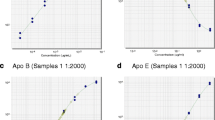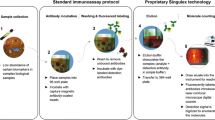Abstract
The purpose of this manuscript is to provide a summary of the evaluation done by the Throughput and Multiplexing subteam on five emerging technologies: Single molecule array (Simoa™), Optimiser™, CyTOF® (Mass cytometry), SQIDLite™, and iLite™. Most of the information is presented with a minimum amount of published data and much is based on discussions with users and the vendor, to help provide the reader with an unbiased assessment of where the subteam sees each technology fitting best in the bioanalysis of large molecules. The evaluation focuses on technologies with advantages in throughput and multiplexing, but is wide enough to capture their strengths in other areas. While all platforms may be suited to support bioanalysis in the discovery space, because of their emergent nature, only Optimiser and SQIDLite are currently ready to be used in the regulated space. With the exception of Optimiser, each instrument/technology requires an up-front investment from the bioanalytical lab that will need justification during capital budget discussions. Ultimately, the platform choice should be driven by the quality of data, project needs, and the intended use of the data generated. In a time- and resource-constrained environment, it is not possible to evaluate all emergent technologies available in the market; we hope that this review gives the reader some of the information needed to decide which technology he/she may want to consider evaluating to support their drug development program in comparison to the options they already have in their hands.





Similar content being viewed by others
References
Rissin DM, Kan CW, Campbell TG, Howes SC, Fournier DR, Song L, et al. Single-molecule enzyme-linked immunosorbent assay detects serum proteins at subfemtomolar concentrations. Nat Biotechnol. 2010;28(6):595–9.
Rissin DM, Fournier DR, Piech T, Kan CW, Campbell TG, Song L, et al. Simultaneous detection of single molecules and singulated ensembles of molecules enables immunoassays with broad dynamic range. Anal Chem. 2011;83(6):2279–85.
Chang L, Rissin DM, Fournier DR, Piech T, Patel PP, Wilson DH, et al. Single molecule enzyme-linked immunosorbent assays: theoretical considerations. J Immunol Methods. 2012;378(1–2):102–15.
Rissin DM, Kan CW, Song L, Rivnak AJ, Fishburn MW, Shao Q, et al. Multiplexed single molecule immunoassays. Lab Chip. 2013;13(15):2902–11.
Kai J, Puntambekar A, Santiago N, Lee SH, Sehy DW, Moore V, et al. A novel microfluidic microplate as the next generation assay platform for enzyme linked immunoassays (ELISA). Lab Chip. 2012;12(21):4257–62.
Zambito F KA, Zhang Y, DeSilva B. Development of a PK immunoassay for a therapeutic monoclonal antibody using OptimiserTM technology. AAPS National Biotechnology Conference; San Diego, CA, USA, 2013.
Bendall SC, Simonds EF, Qiu P, el Amir AD, Krutzik PO, Finck R, et al. Single-cell mass cytometry of differential immune and drug responses across a human hematopoietic continuum. Science. 2011;332(6030):687–96.
Giesen C, Wang HAO, Schapiro D, Zivanovic N, Jacobs A, Hattendorf B, et al. Highly multiplexed imaging of tumor tissues with subcellular resolution by mass cytometry. Nat Methods. 2014;11(4):417–22.
Lea P, Keystone E, Mudumba S, Kahama A, Ding SF, Hansen J, et al. Advantages of multiplex proteomics in clinical immunology: the case of rheumatoid arthritis: novel IgXPLEX: planar microarray diagnosis. Clin Rev Allergy Immunol. 2011;41(1):20–35.
Gupta S, Indelicato SR, Jethwa V, Kawabata T, Kelley M, Mire-Sluis AR, et al. Recommendations for the design, optimization, and qualification of cell-based assays used for the detection of neutralizing antibody responses elicited to biological therapeutics. J Immunol Methods. 2007;321(1–2):1–18.
Tovey MG, Lallemand C. Improved analytical methods for the detection and quantification of neutralizing antibodies to biopharmaceuticals. Bioanalysis. 2012;4(17):2179–90.
Lallemand C, Meritet JF, Erickson R, Grossberg SE, Roullet E, Lyon-Caen O, et al. Quantification of neutralizing antibodies to human type I interferons using division-arrested frozen cells carrying an interferon-regulated reporter-gene. J Interferon Cytokine Res. 2008;28(6):393–404.
Lallemand C, Kavrochorianou N, Steenholdt C, Bendtzen K, Ainsworth MA, Meritet JF, et al. Reporter gene assay for the quantification of the activity and neutralizing antibody response to TNFalpha antagonists. J Immunol Methods. 2011;373(1–2):229–39.
Acknowledgments
The authors acknowledge Frank Zambito from BMS and Melissa Wojick from Biogen Idec for their user perspective on the Optimiser technology, Andreas Jeromin for his perspective on the Simoa technology, Kondala Atkuri and Robert Smith from Pfizer for their user perspective on the CyTOF technology, and Steven Piccoli for his review and comments on the manuscript.
Author information
Authors and Affiliations
Corresponding author
Additional information
Guest Editors: Johanna Mora and Binodh Desilva
The opinions presented in this manuscript reflect those of the authors and do not reflect the opinions of the companies represented here.
Rights and permissions
About this article
Cite this article
Mora, J., Chunyk, A.G., Dysinger, M. et al. Next Generation Ligand Binding Assays—Review of Emerging Technologies’ Capabilities to Enhance Throughput and Multiplexing. AAPS J 16, 1175–1184 (2014). https://doi.org/10.1208/s12248-014-9660-1
Received:
Accepted:
Published:
Issue Date:
DOI: https://doi.org/10.1208/s12248-014-9660-1




